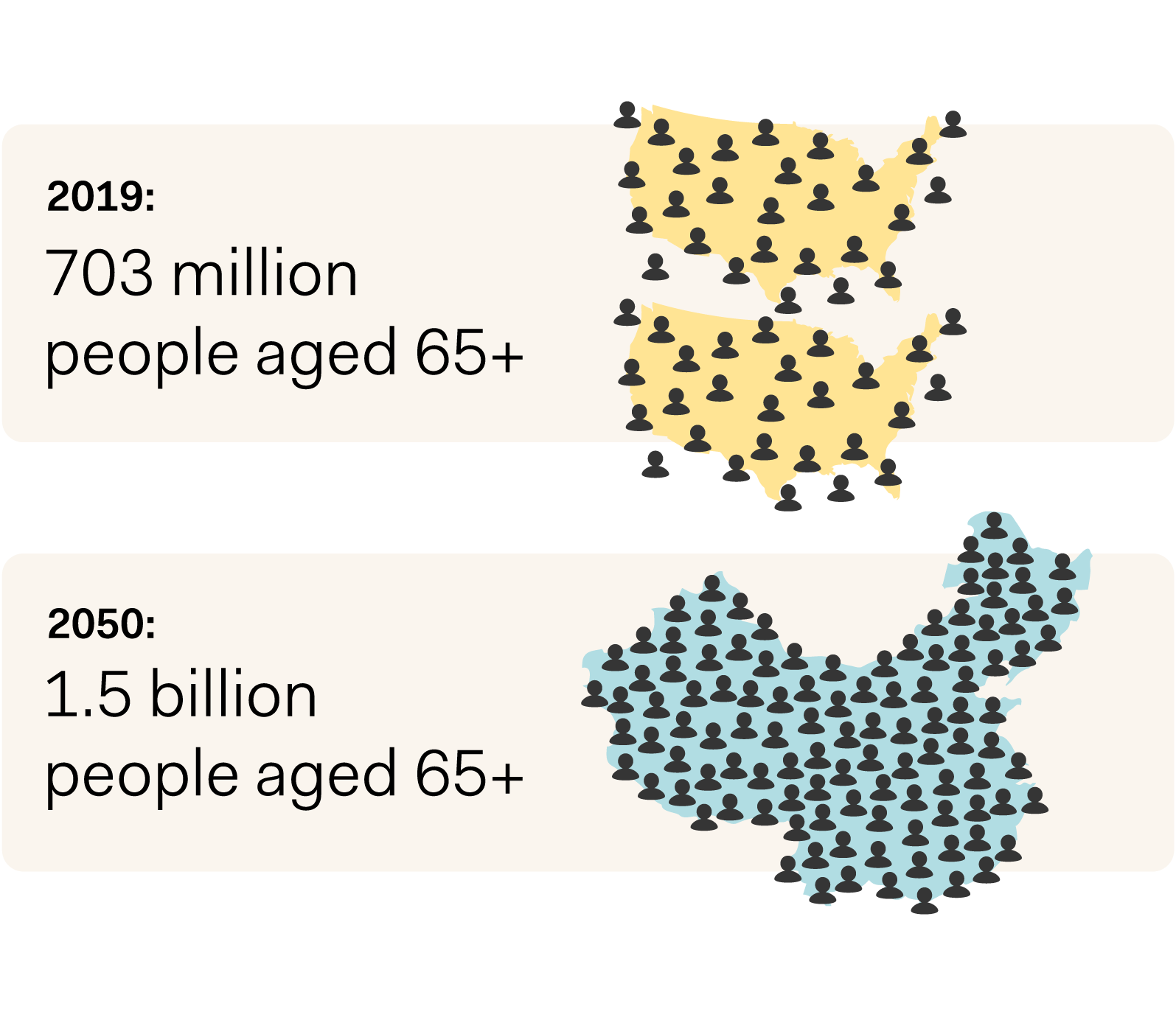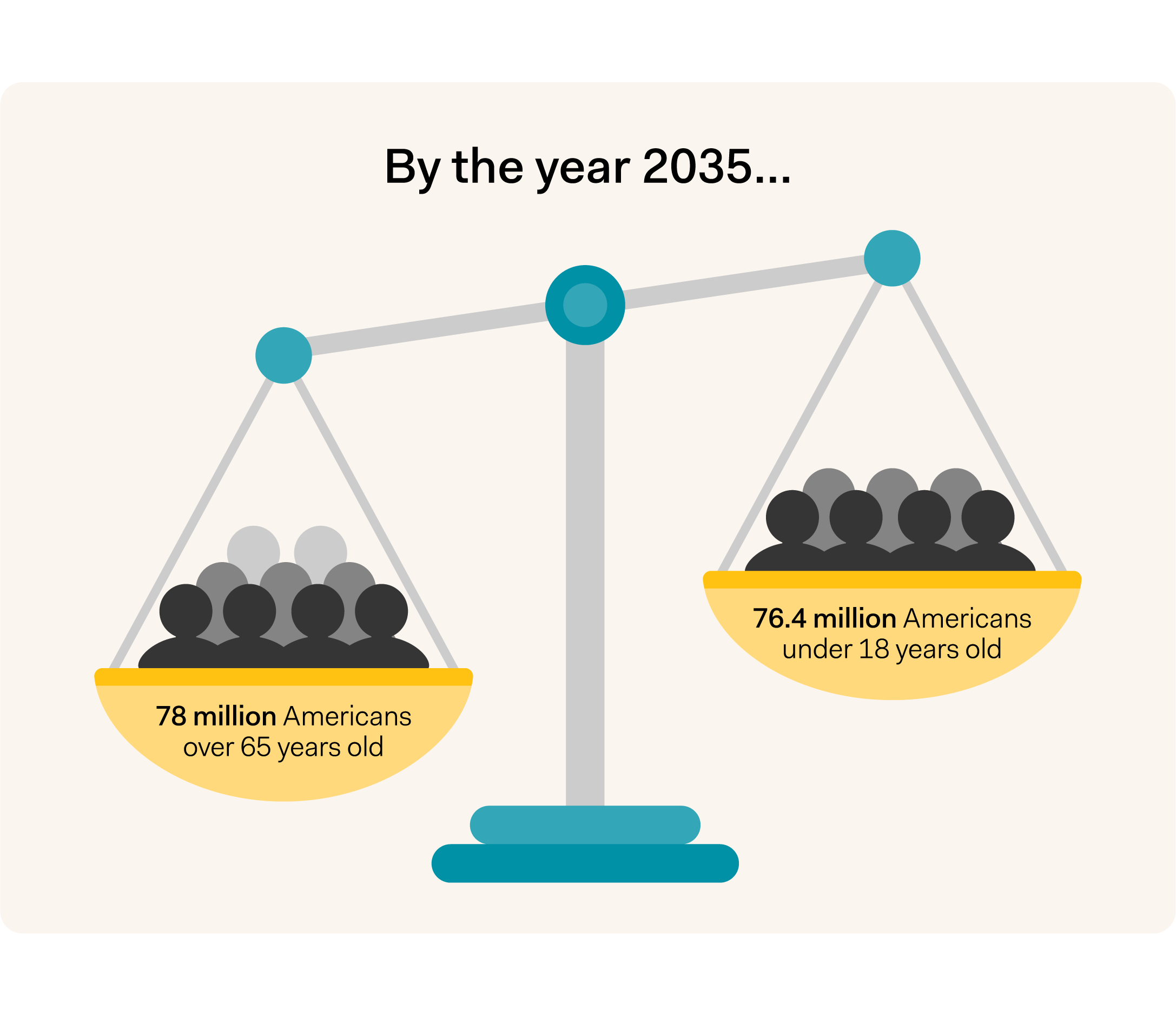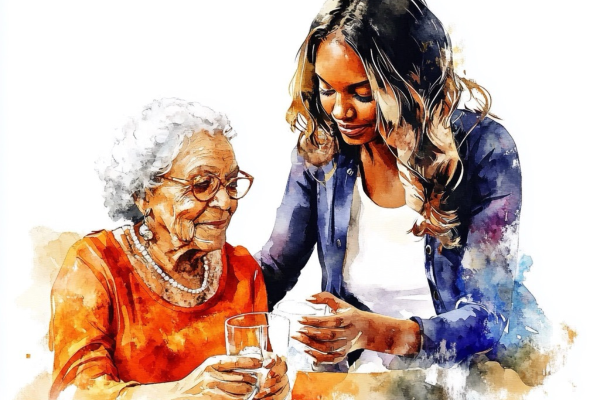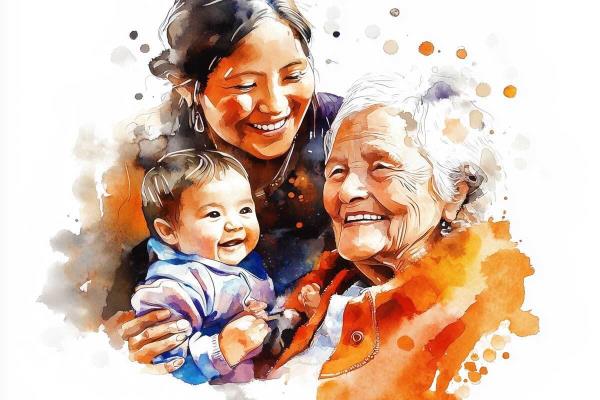Is anyone else suffering from Global Crisis Fatigue? It really seems like they’ve been piling up over the last few decades. Pandemics, climate change, food scarcity, human rights. It feels like our planet and her people are more vulnerable than ever. How do we begin to fix it all?
It helps to focus. My focus is on one segment of the population that’s especially vulnerable and especially big. But they’re not top of mind for a lot of people. And that’s aging adults—men and women over 65. No matter our age or our family makeup, we should all be thinking about and talking about this ballooning population. Because how they age impacts all of us. And their numbers are growing. Fast.
Aging by the numbers
A 2019 UN report counts about 703 million people 65+ living on Earth. To put that number into perspective, that’s more than twice the entire population of the United States. By 2050, the same report projects that number will reach 1.5 billion, or a bit more than the entire population of China.

That’s a lot of aging adults to support and care for. In fact, as far back as 2013, the Commonwealth Fund referred to the aging population as “A Crisis in Plain Sight.” Three years later, the World Economic Forum (WEF) included the aging population in its top ten global challenges, along with crises like climate change and food scarcity. Specifically, WEF asks, “How can the global health system adapt to demographic changes?”
It’s not just the sheer number of aging adults that’s causing this crisis. It’s also the percentage of the population that they represent. Globally, older adults outnumber the young for the first time ever. Come 2030, all U.S. baby boomers will be older than 65, putting one in every five Americans at retirement age. Five years later, there will be 78.0 million Americans 65 years and older compared to 76.4 million under 18 according to the 2018 U.S. Census. And adults over 80? That number is growing even faster. Globally, their numbers are expected to more than triple by 2050.

This imbalance means that fewer younger people will be providing some type of care or support to more older people. The U.S. Department of Health and Human Services projects that by 2050, 27M Americans will need the aid of some kind of caregiver. The big question is, who will provide that care?
This is everybody’s problem
I just threw a lot of numbers at you. And yes, they’re impressive. Mind-boggling, even. But when you start connecting the dots, you can see how this inversion of the aging pyramid has the potential to affect just about every aspect of our lives.
Labor supply
More aging adults mean fewer people in the labor market. Jobs will be harder to fill, which will have the ripple effect of driving up hiring costs and salaries and impacting corporate balance sheets. Alternatively, it could increase already heavy workloads, which can impact mental and physical wellbeing and employee retention. Some of this shrinking labor supply includes doctors, hospital staff, and caregivers—exactly the service providers that aging adults need most.
Prices
As a shrinking labor supply drives up corporate payrolls, companies compensate by raising prices on goods and services. This won’t just impact the stuff that aging adults need. It will impact everything. But as the demand for goods and services for aging adults rises, those costs could be among the first to go up.
Families
Who will be caring for our aging loved ones (or us)? We can’t continue to count on adult children to do it all, especially if they have full time careers and kids of their own at home. There are only so many hours in a day.
A couple of generations ago, larger families meant caring for aging parents could be divvied up among a half dozen or more kids. With smaller families, caregiving responsibilities often fall predominantly on the shoulders of one or two adult children—usually daughters who are also their children’s primary caregivers. These women often have to reduce their working hours, and therefore their income, to keep everyone afloat. Or they leave their jobs completely, further reducing the shrinking workforce.
Some older adults are fortunate enough to be able to afford long term care insurance (LTCI). This can cover some or all of the cost of home care or care in a congregate living facility for a specified number of years. But because people are living longer, and often in poorer health, fewer insurance companies are offering these policies. If they are, the benefits aren’t as robust as they once were and the premiums are higher. Without LTCI, many families can’t afford to fund professional care for their loved ones.
Spending Patterns
With more of families’ discretionary income covering expenses related to aging—health care, prescriptions, medical equipment, professional caregiving—and less discretionary income to work with due to time taken away from work, spending patterns will change, big time. Fewer meals out, less entertainment, less vacation travel, and fewer ‘nice-to-have’ purchases will have ripple effects across an array of industries, business, and workers.
All of the above will profoundly impact our economy and our society. If we can’t provide the care that our aging population needs, their plight will be society’s plight. If we can care for them, we’ll lift them up, and in doing so, lift society up.
What can we do?
As a society, we need to dial up investments in innovative approaches to make it easier for more aging adults to live safely where they wish to live, longer. For 90% of these folks, that place is their home. In the past decade or two we’ve seen progress with innovations that can make this possible. Driverless cars and smart homes could extend the independence of adults who wish to age in place. Domestic robots can help ease the burden of home maintenance. But we can’t count on technology alone to care for our aging population. Because care is a distinctly human endeavor.
This is why the company I helped found, Honor, is focused on developing home care technology that uplifts professional caregivers—we call ours Care Professionals, or Care Pros for short—and helps them provide the best possible care to aging adults. That human component is absolutely necessary to maintain quality of life.
Because a lot of what we build focuses on improving the Care Pro experience, we’ve been able to attract quality Care Pros, even during what the home care industry is experiencing as a Care Pro shortage. But home care companies everywhere, including Honor, still need to address the imbalance of a growing aging population and a shrinking workforce. Essentially, we’ll need to innovate ways for fewer people to care for more people.
Maybe it’s a shared care model, where two unrelated clients receive care from one Care Pro in one home. Or maybe we need to reach people when they’re younger and intervene with lifestyle approaches that can extend their health span and reduce their need for acute care later in life. Maybe we need governments to step up and ensure older adults at all socioeconomic levels have access to quality home care. But we have to do something—or a lot of things—to mitigate this crisis.
We absolutely have to start by getting more people to think and talk about it. But we also need to engage innovators and governments in developing solutions fast. Look how long it’s taken to get meaningful action on climate change—a crisis that everyone’s been thinking and talking about for decades. We don’t have that kind of runway. The good news is that investors are eager to support companies innovating in this space. And since no one is immune to aging, we can hope that governments can see this as the bipartisan issue it is. Meanwhile, at Honor, we’ll keep doing our part to improve the aging experience for all and expand the world’s capacity to care.
Keep your eye out for the second article in this series: Why Care Hasn’t Scaled.
If you're interested in learning more about Honor, or joining our team, visit this page.




